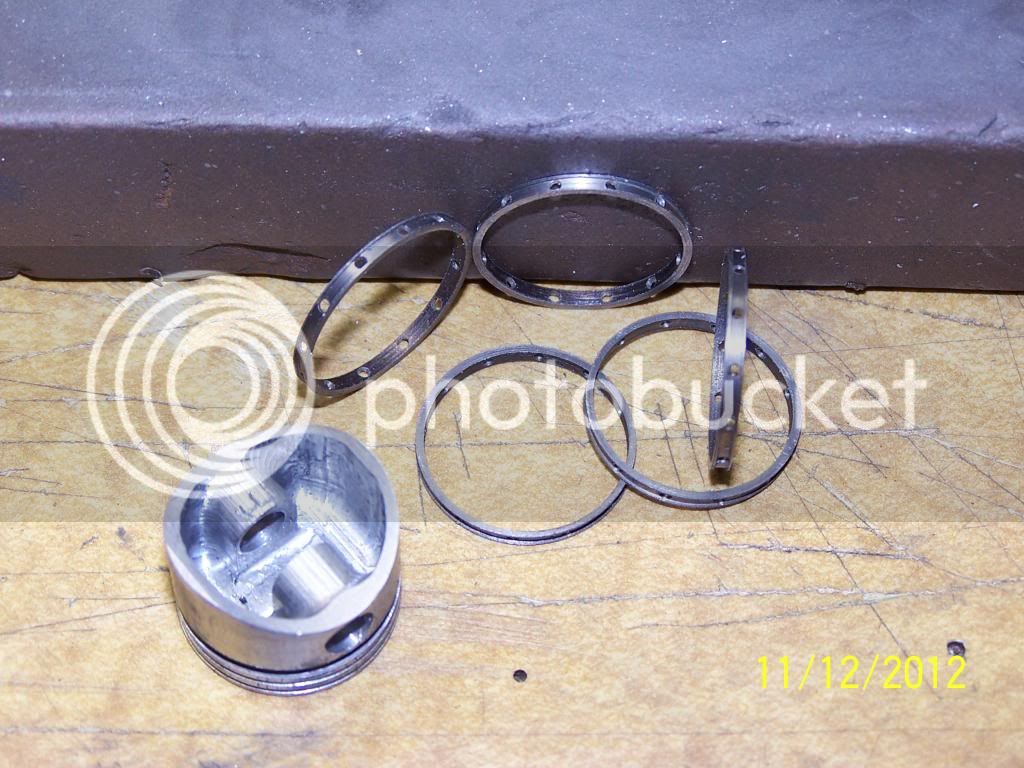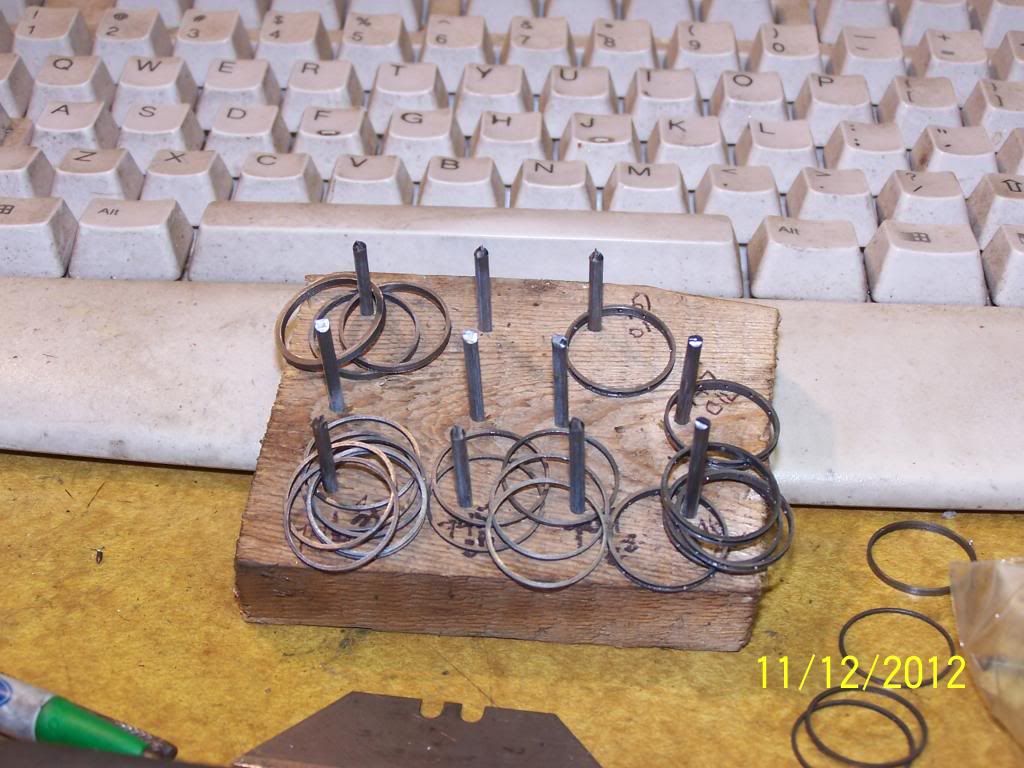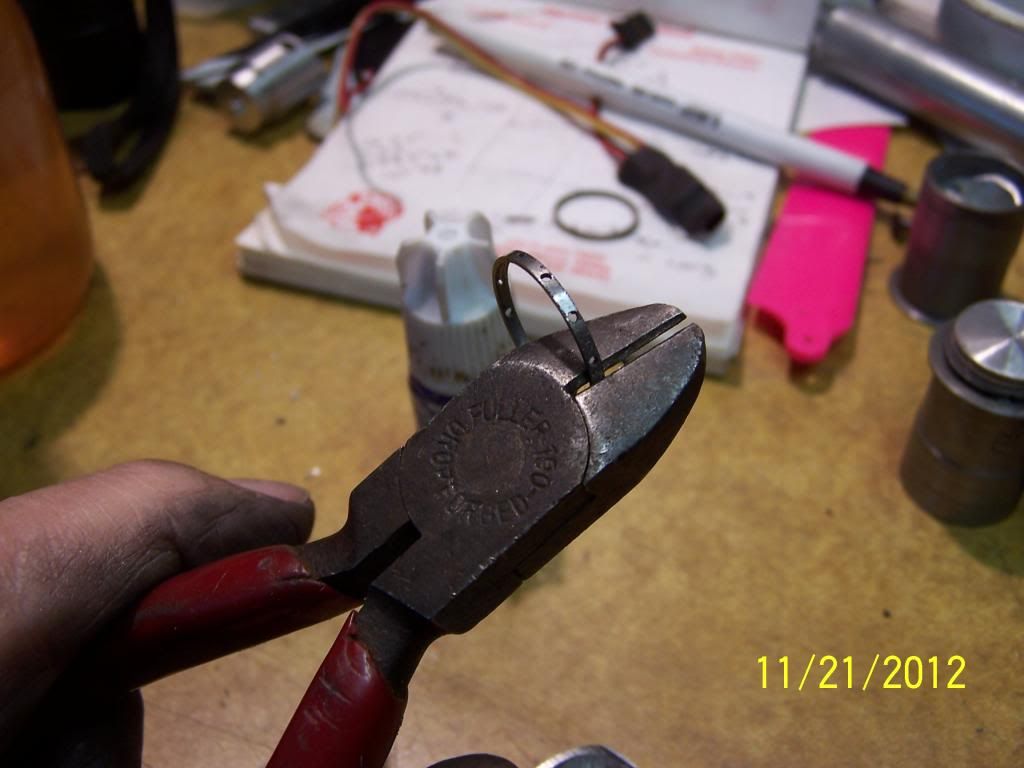You are using an out of date browser. It may not display this or other websites correctly.
You should upgrade or use an alternative browser.
You should upgrade or use an alternative browser.
Jim builds his second v-8
- Thread starter jpeter
- Start date

Help Support Home Model Engine Machinist Forum:
This site may earn a commission from merchant affiliate
links, including eBay, Amazon, and others.
It's fall and time to get back to the shop. By looking at the date on the last entry I've not worked on the v8 since February. Well here we go. I needed some rods so I made a few yesterday. Here's what I ended up with. BTW, 2-56 screws.
Got a piston in the picture too. Finished that some time ago but have yet to turn it to final dia./length and cut the ring grooves so its a ways from being done. Notice though how I pocketed the inside.
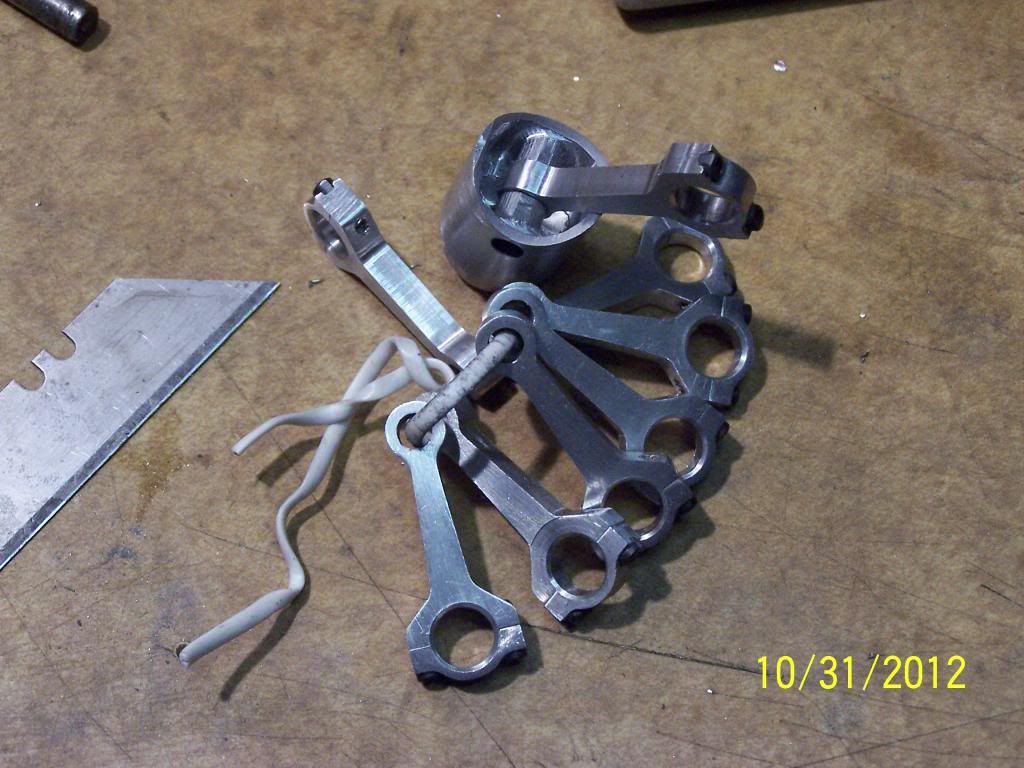
Got a piston in the picture too. Finished that some time ago but have yet to turn it to final dia./length and cut the ring grooves so its a ways from being done. Notice though how I pocketed the inside.

Last edited:
- Joined
- May 30, 2011
- Messages
- 135
- Reaction score
- 4
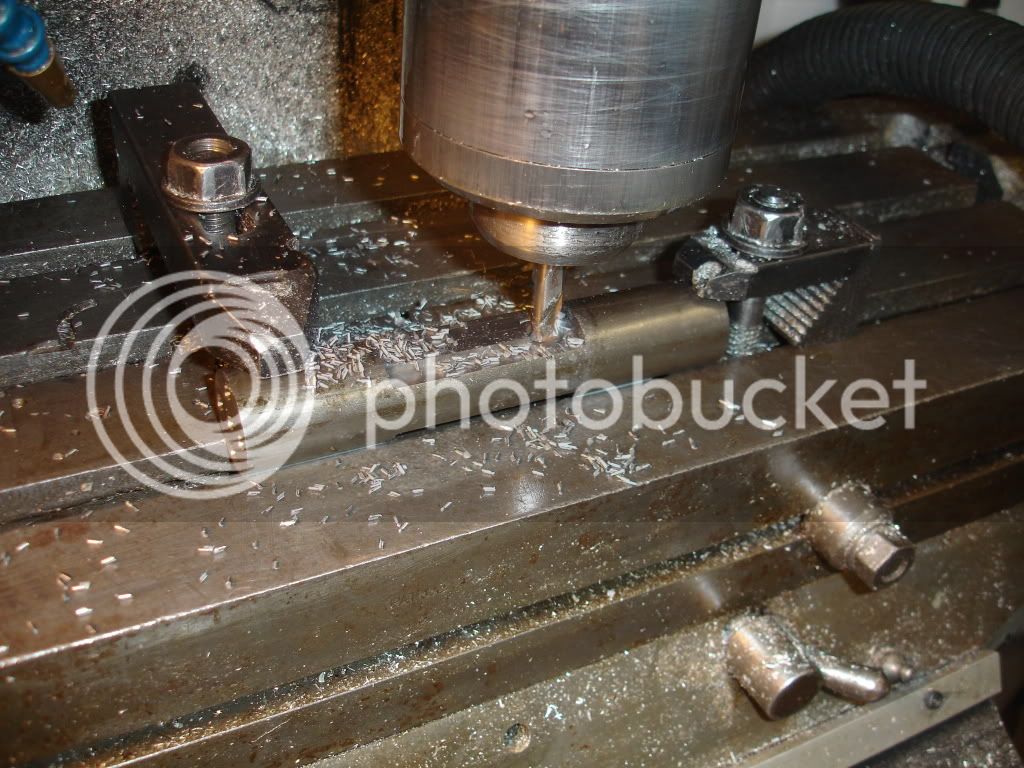
Notice the 5 centerbores in the end. The hidden end has similar centerbores.
Its time to mount it in the lathe. I first placed a piece of bar in the chuck and turned a live center. I have a live center that fits in the spindle taper but I like the chuck idea cuz I think its more accurate, less likely to wobble.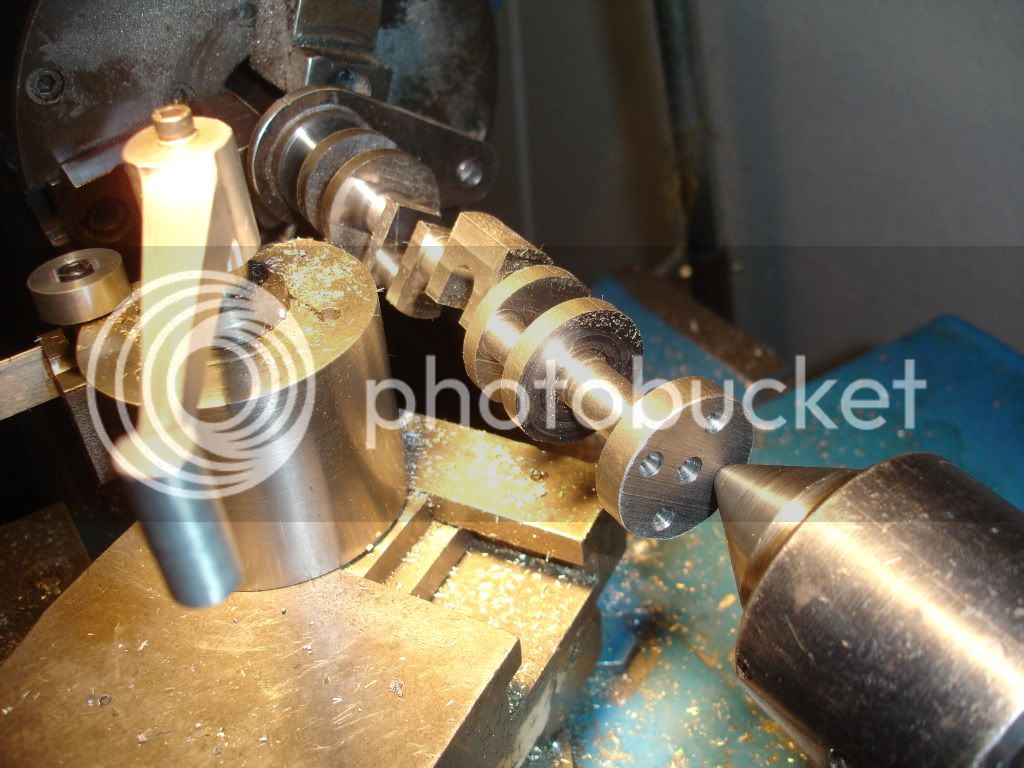
I rough in the main first.
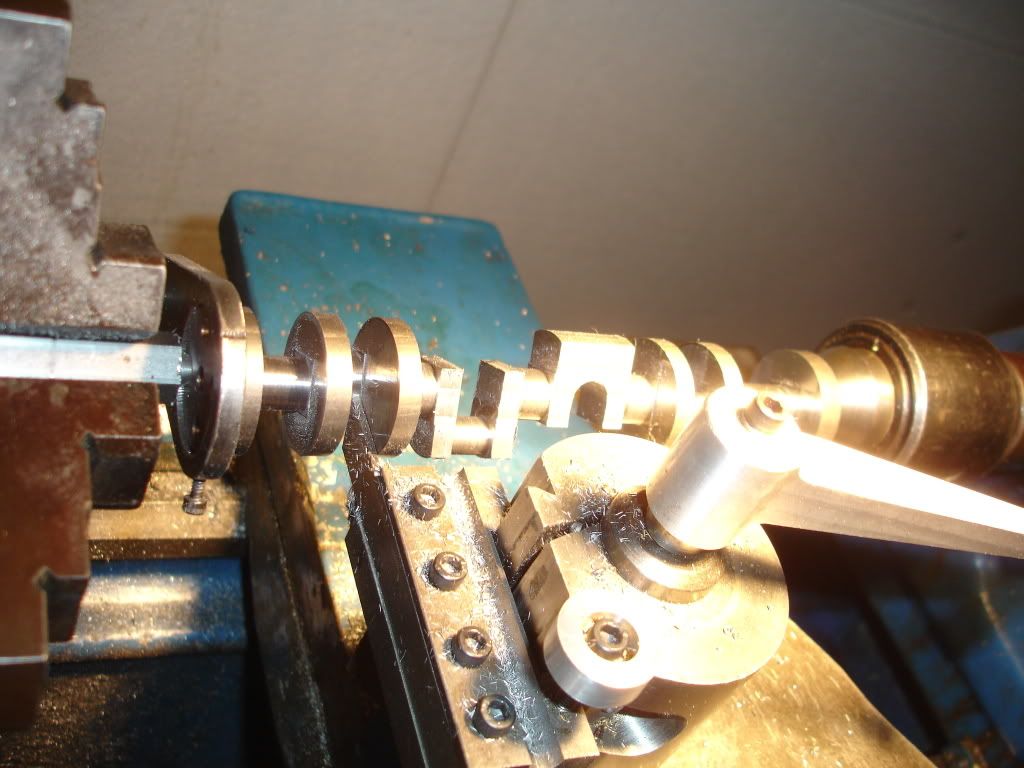
Next I turned the throw pins to final size. The tool looks like a parting tool and it is but its been ground to more resemble a turning tool. The corners have been broken. Having a chamfer in the corners strengthens the crank. I'll releave the rods to allow for the chamfer.
I haven't been following this build, but will sure enough browse through the rest of the excellent progress achieved with this engine.
Curious to know how you were able to form the 5 centerbores on both ends of the crankshaft. How did you align it such to have the paired centerbores opposite of one another yet parallel along the axis?
Ian
"Curious to know how you were able to form the 5 centerbores on both ends of the crankshaft. How did you align it such to have the paired centerbores opposite of one another yet parallel along the axis?"
Thanks for the question. Answer is that within reason they don't need to be aligned cuz any misalignment gets turned out. To get them close though I first clamped the bar on the mill table and milled a flat on each end of the bar. I then stood the bar in the mill vise with the flat against the solid jaw, dialed in the center and center drilled the spots, flipped the bar end for end and did it again. Yeah, the bar was sticking up 6 inches.
Thanks for the question. Answer is that within reason they don't need to be aligned cuz any misalignment gets turned out. To get them close though I first clamped the bar on the mill table and milled a flat on each end of the bar. I then stood the bar in the mill vise with the flat against the solid jaw, dialed in the center and center drilled the spots, flipped the bar end for end and did it again. Yeah, the bar was sticking up 6 inches.
Last edited:

$39.99
$49.99
Sunnytech Low Temperature Stirling Engine Motor Steam Heat Education Model Toy Kit For mechanical skills (LT001)
stirlingtechonline

$45.99
Sunnytech Mini Hot Air Stirling Engine Motor Model Educational Toy Kits Electricity HA001
stirlingtechonline

$89.99
Outdoor Wood Boiler Water Treatment Rust Inhibitor- AmTech 300 & Test Kit
Alternative Heating & Supplies

$39.58
$49.99
Becker CAD 12 3D - professional CAD software for 2D + 3D design and modelling - for 3 PCs - 100% compatible with AutoCAD
momox Shop
![DreamPlan Home Design and Landscaping Software Free for Windows [PC Download]](https://m.media-amazon.com/images/I/51kvZH2dVLL._SL500_.jpg)
$0.00
DreamPlan Home Design and Landscaping Software Free for Windows [PC Download]
Amazon.com Services LLC

$25.34
$34.99
Bowl Sander Tool Kit w/Dual Bearing Head & Hardwood Handle | 42PC Wood Sander Set | 2" Hook & Loop Sanding Disc Sandpaper Assortment | 1/4" Mandrel Bowl Sander for Woodturning | Wood Lathe Tools
Peachtree Woodworking Supply Inc

$29.95
Competition Engine Building: Advanced Engine Design and Assembly Techniques (Pro Series)
Amazon.com Services LLC

$99.99
AHS Outdoor Wood Boiler Yearly Maintenance Kit with Water Treatment - ProTech 300 & Test Kit
Alternative Heating & Supplies

$519.19
$699.00
FoxAlien Masuter Pro CNC Router Machine, Upgraded 3-Axis Engraving All-Metal Milling Machine for Wood Acrylic MDF Nylon Carving Cutting
FoxAlien Official

$94.99
$109.99
AHS Woodmaster 4400 Maintenance Kit for Outdoor Wood Boiler Treatment
Alternative Heating & Supplies
Steve, going to the meeting Wed?
Yes I plan to be there. Nothing to show but I hope to have the garage cleaned up and get back to biz real soon.
- Joined
- May 30, 2011
- Messages
- 135
- Reaction score
- 4
"Curious to know how you were able to form the 5 centerbores on both ends of the crankshaft. How did you align it such to have the paired centerbores opposite of one another yet parallel along the axis?"
Thanks for the question. Answer is that within reason they don't need to be aligned cuz any misalignment gets turned out. To get them close though I first clamped the bar on the mill table and milled a flat on each end of the bar. I then stood the bar in the mill vise with the flat against the solid jaw, dialed in the center and center drilled the spots, flipped the bar end for end and did it again. Yeah, the bar was sticking up 6 inches.
Not sure how that would be ok. Wouldn't the crankpins be slightly off then? Wouldn't that then cause the pistons to be in the incorrect position in relation to each other? or is there a decent tolerance for engines?
Wow, that really does sound effective. Having that flat spot would prevent it from rotating out of position when flipping it end over end. Ingenious!
Ian
Not sure how that would be ok. Wouldn't the crankpins be slightly off then? Wouldn't that then cause the pistons to be in the incorrect position in relation to each other? or is there a decent tolerance for engines?
Wow, that really does sound effective. Having that flat spot would prevent it from rotating out of position when flipping it end over end. Ingenious!
Keep in mind, once centered between two center spots any throw pins turned will be on that centerline. The throw plates are slightly off but they get faced in the same operation so that brings them back on. I like to finish the mains last because I find having the 5 mains lined up is critical so any previous minor bending or warping gets turned out as a final operaton. Slight misalignments of the throws can be tolerated.
There's been lots of discussions on how to make mult-cylinder cranks. Its a tough project and lots of methods have been suggested. My method for sure is not the only workable solution but I will say if done carefully it gets the job done. For me the biggest advantage is using milling to remove most of the excess metal. I've tried lathing the whole thing. That's an exercise in frustration, at least for me. I've tried building up cranks from side plates and silver solder too. I've got single cylinder engines running that way. But with multi's,it's too tough for me to get the mains straight cuz the heat warps everything.
I'm open to other opinions. I'd be fun to hear other's experiences.
Last edited:
I've got to split the rings before heat treat. Clieving compression rings is easy but I'm bewildered about slitting the oil rings. Seems the oil rings don't clieve to neatly. Any suggestions?
KBC tool has slitting/slotting saw blades as thin as .008 if you want to try to cut one
Doing the heat treat. The thickness of the plate is important, about 1/8 inch. Turn the steel slightly dull red, remove the torch and let the ring cool for a minute or so. Getting it too hot is bad for warpage. To size the gap I grind it with a Dremel disc. I've tried filing them but end up too often breaking them. Place the tool in a vise, open the ring so the disc is in the gap and touch it to the wheel. Works well.
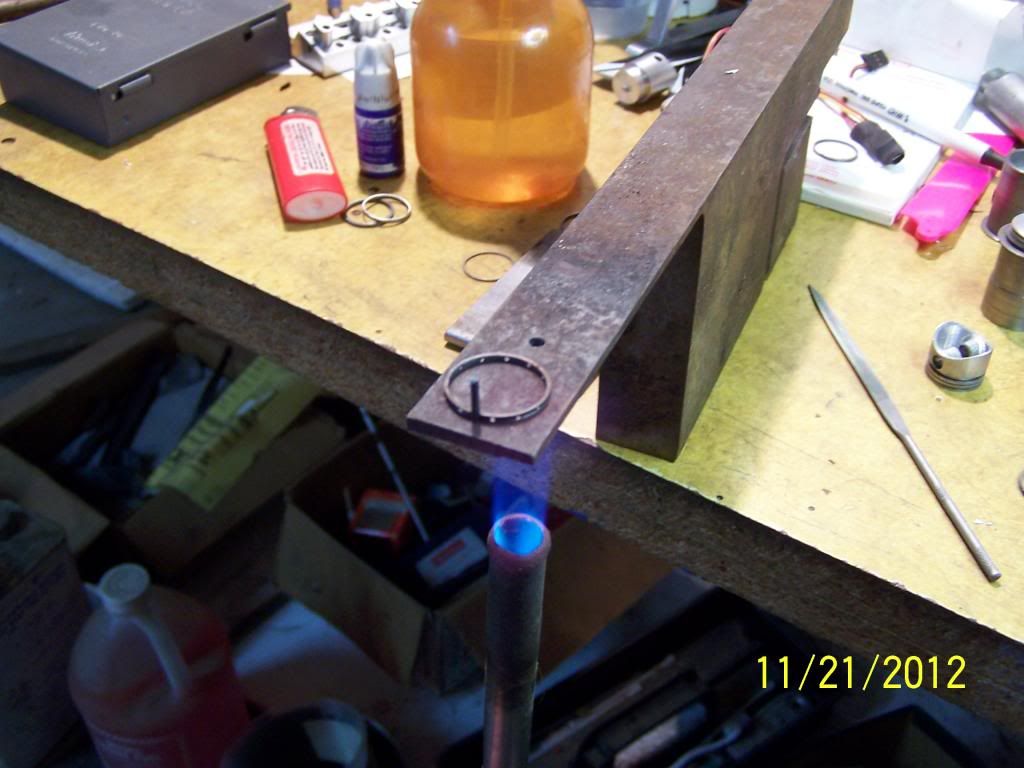

Ahh, found the switch to editor mode. So here's a cylinder. Got the o-ring groove and o-ring in place. I used extra soft o-rings from McMaster-Carr. The plan is to seal the water jacket from the crankcase. Haven't yet tested it for leaks. I grease them up with Vaseline and slide the sleeve in. Seems to work.

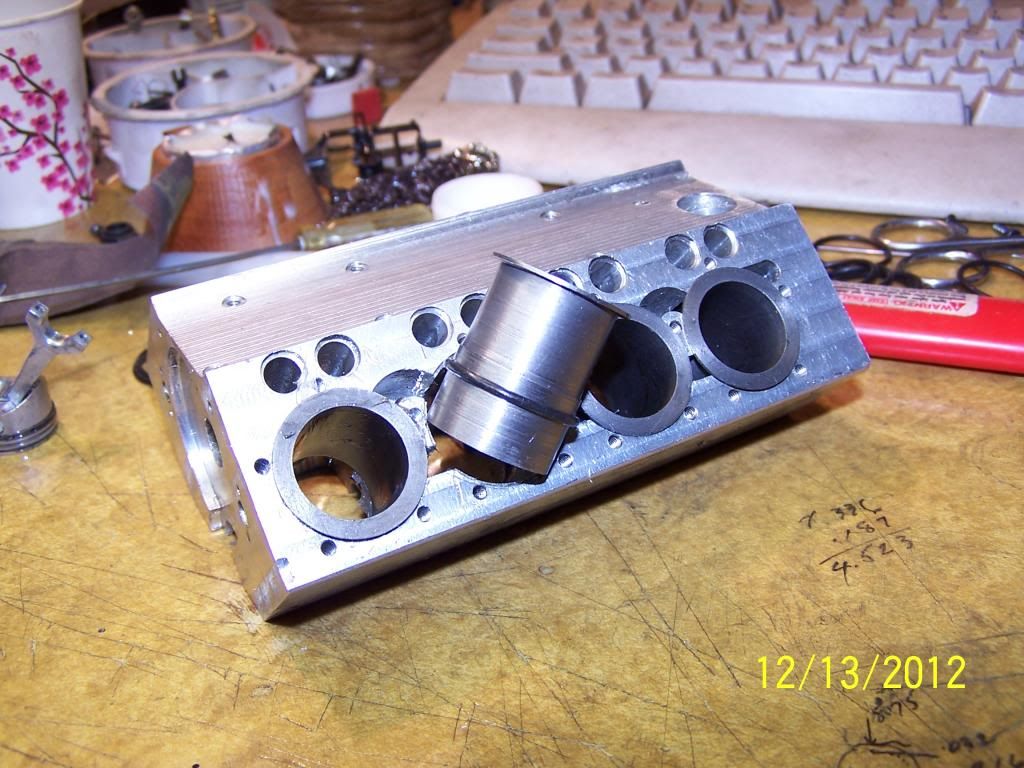
The cut in the block upper right of the right sleeve is where the water passes up into the head. The head has a hole drilled full length taking the water back to the front of the head then into the intake manifold. The next post will show the intake in place with the goose neck screwed on.


The cut in the block upper right of the right sleeve is where the water passes up into the head. The head has a hole drilled full length taking the water back to the front of the head then into the intake manifold. The next post will show the intake in place with the goose neck screwed on.
Last edited:
Here's a pic showing the way the intake mates up with the heads. Notice the plug in the lower right end of the head. The water passage is blocked off by that plug. Water turns just inside the end of the head and routes up through the manifold and out the goose neck. The goose neck pipe was machined in two halves then glued together with J&B weld, which was then glued to the base flange. The pipe extends into the flange all the way to the manifold. The pipe id is 3/16 inch. The left head has the same passage. The flange screws are 2-56.


Last edited:
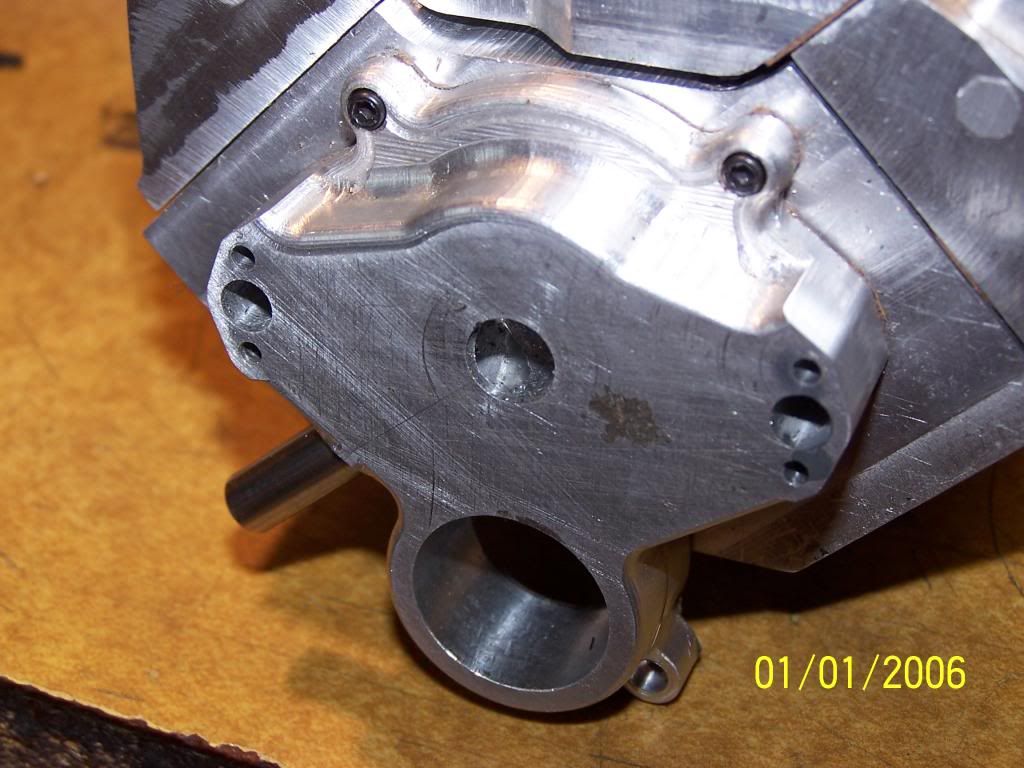
This this is a picture of the gear cover/water pump base. The hole in the center is the water intake into the pump. The left and right holes are pump outlets directly to the block.
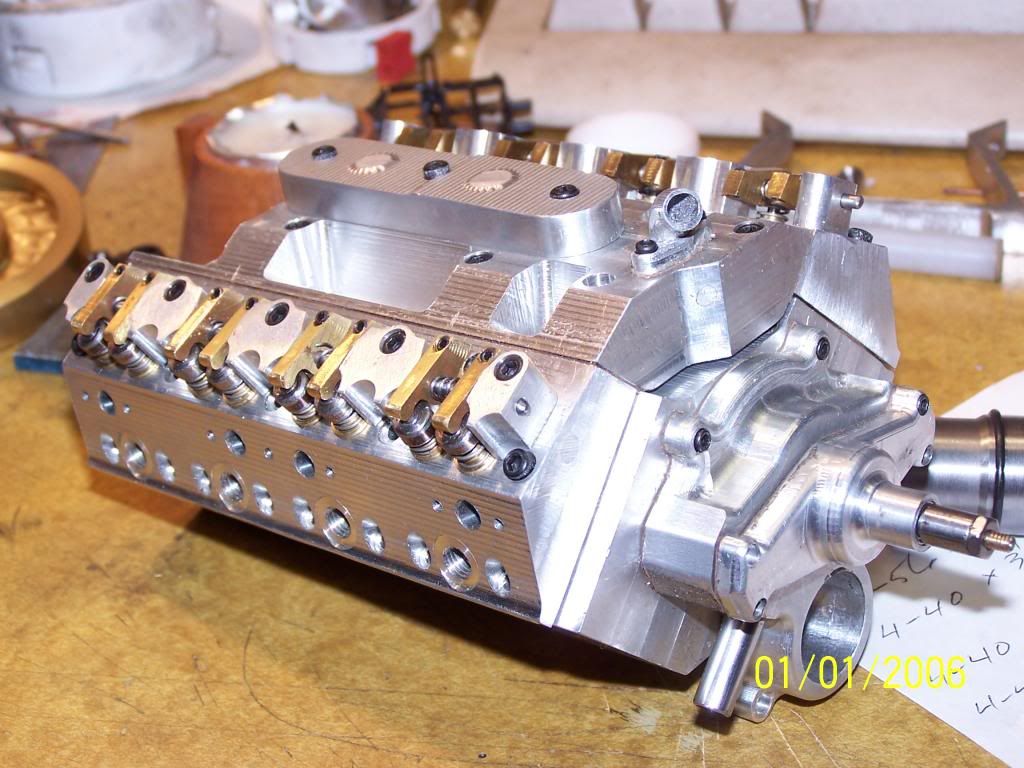
Here the pump is mounted. Hope it works. I'm worried about my shaft seal. Couldn't afford a seal for an 1/8 inch shaft so I drilled a length of teflon rod for a seal. We'll see.
Last edited:
I like this picture. Its a recent shot of the bottom end. It shows the bearing shells and the shaft tunnel. Look in the tunnel and you can see where the tappets will be contacting the cam. I used a ball end mill to mill the pockets for the crank. To save time I used a rather large scallop height. A finer surface would make for better pictures. I should have cleaned it for the picture. Its covered with Vaseline from sliding in the sleeves. Never the less, I like it.
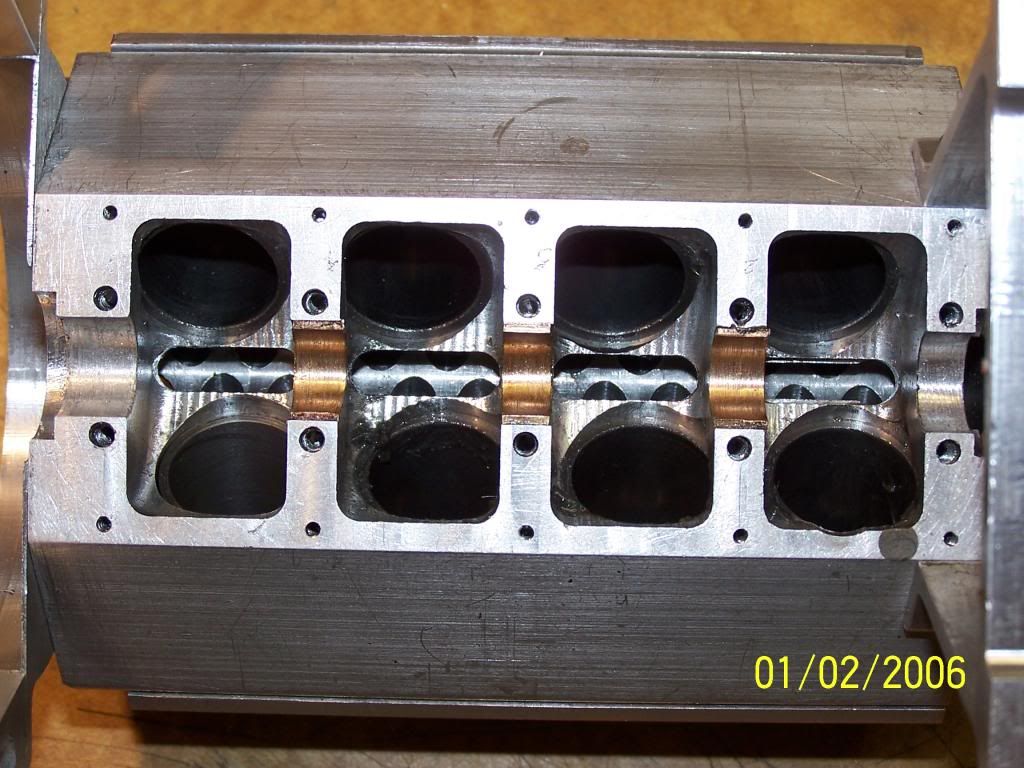

smartrobert
New Member
- Joined
- Feb 7, 2011
- Messages
- 2
- Reaction score
- 0
It's unbelievable. Thanks.
Robert
Robert
Similar threads
- Replies
- 2
- Views
- 1K




